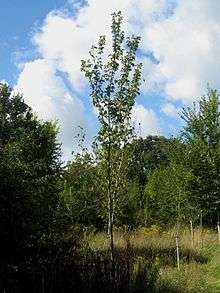Ulmus 'Wanoux' = Vada
| Ulmus hybrid cultivar | |
|---|---|
 VADA, aged 8 years, Great Fontley, UK | |
| Hybrid parentage | 'Plantyn' × 'Plantyn' selfed |
| Cultivar | 'Wanoux' = Vada™ |
| Origin | Netherlands |
Ulmus 'Wanoux' (selling name Vada™) is a Dutch hybrid cultivar arising from the crossing of 'Plantyn' with another, selfed (self-pollinated), specimen of 'Plantyn'. Originally identified as clone No. 762, it was selected for assessment by the French Institut National de la Recherche Agronomique (INRA), which patented it as 'Wanoux' (Vada) in 2006.
Description
Vada is a narrow tree primarily intended for street planting. The glossy, dark-green leaves, < 11 cm long by 8 cm wide, are coarsely toothed and have conspicuous venation [1] Towards the end of the season however, the leaves suffer from various afflictions so they can appear shabby. Leafing is late, but not quite as late as its stablemate Lutèce. Many minor buds fail to burst, so that young plants are rather sparsely furnished; in combination with the tree’s limited lateral development, this can lead to a skeletal appearance.[2]
Pests and diseases
Tests in France by INRA found the tree to be 'highly resistant' to Dutch elm disease, exhibiting the lowest wilting percentage of all the clones trialled, making it comparable with 'Sapporo Autumn Gold' [3] However, the presence of U. wallichiana in the ancestry of Vada poses the risk of susceptibility to elm yellows (phloem necrosis), which seriously damaged its Dutch stablemate 'Lobel' used as a control in the Italian elm breeding programme.[4] The clone has also proven susceptible to Coral spot fungus Nectria cinnabarina in the Netherlands.[5]
In trials in southern England, the leaves were found to remain completely free of Black Spot. .[6]
Cultivation
Vada has moderate vigour, attaining a height of 14 m at 20 years of age in France.[1] The tree is reputedly easily propagated from cuttings. Vada was introduced to North America in 2010, with the supply of two small specimens to the USDA, Washington, D.C., released from quarantine in 2013. Vada is not known to have been introduced to Australasia.
Notable trees
Former French prime minister Lionel Jospin insisted on planting an elm, the tree of the Left when, in keeping with tradition, he was obliged to plant a tree in the garden of the Hôtel Matignon, his official residence in Paris, in 1998. He chose Vada, then still known only by its Dutch trial identity of '762'. The Left, however, do not have a monopoly on elms. 'The Queen’s Elm' planted on the main lawn of Holyrood Palace, Edinburgh, near the ruined Holyrood Abbey, to mark the Diamond Jubilee of Elizabeth II, is also an Ulmus ‘Wanoux’.[7]
 'The Queen’s Elm', Holyrood Palace
'The Queen’s Elm', Holyrood Palace
Etymology
The selling name VADA is the ancient Roman name for the town of Wageningen, in the Netherlands, where the clone was raised.
Accessions
Europe
- Grange Farm Arboretum, Sutton St. James, Spalding, Lincs. UK. Acc. no. 693.
- Great Fontley Farm, Fareham, UK, Butterfly Conservation Elm Trials plantation, Home Field: two small trees planted 2008.
- Longstock Park Arboretum, Longstock, Stockbridge, Hampshire, UK. One small tree planted 2010.
- Royal Botanic Garden Edinburgh, UK. Acc. no. 20090115.
- Sir Harold Hillier Gardens, UK. Acc. no. 2008.0639.
- Wijdemeren City Council, Netherlands, Elm collection, used for elm lane 's-Gravelansevaartweg, Loosdrecht
North America
- National Arboretum, Washington, D.C.. 2 small trees.
References
- 1 2 Pinon, J. 2007). Les ormes résistants à la graphiose (:Elms resistant to Dutch Elm Disease). Forêt-entreprise, No. 175 - Juillet 2007, 37–41, IDF, Paris, France. http://www.foretpriveefrancaise.com/data/info/127219-P.pdf
- ↑ Herling, D. Resistant Elms
- ↑ Pinon, J., Lohou, C. & Cadic, A. (1998). Hybrid Elms (Ulmus Spp.): Adaptability in Paris and behaviour towards Dutch elm disease (Ophiostoma novo-ulmi). Acta Horticulturae 496, 107–114, 1998.
- ↑ Mittempergher, L., (2000). Elm Yellows in Europe. In: The Elms, Conservation and Disease Management. 103–119. Dunn C.P., ed. Kluwer Academic Press Publishers, Boston, USA.
- ↑ Nijboer, R. (2016). Return of the Elm. 2016 International Elm Conference, Lees Court, Kent, England.
- ↑ Brookes, A. H. (2015). Disease-resistant elms, Butterfly Conservation trials report, 2015 Butterfly Conservation, Hants & IoW Branch, England.
- ↑ 'Survey of the elms of Holyrood Palace', Dr Max Coleman, Royal Botanic Garden Edinburgh, 22/07/2016 (updated 11/08/16)